There were 2 posts tagged: Ultra Noise-Cancelling
Headset Microphones: Which One is Right for You? Part 1 of 2
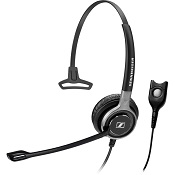 Office headsets, used for desk phones, computers and mobile phones, can keep your hands free, allowing you to talk while you work, type and even run errands! Choosing the right office headset can be an overwhelming task; by simplifying your choices and clarifying the options, we find the best solution for you. Part of the decision-making process is selecting a headset with a microphone that provides optimal communication.
Office headsets, used for desk phones, computers and mobile phones, can keep your hands free, allowing you to talk while you work, type and even run errands! Choosing the right office headset can be an overwhelming task; by simplifying your choices and clarifying the options, we find the best solution for you. Part of the decision-making process is selecting a headset with a microphone that provides optimal communication.There are three main types of microphones available on the market today. We've laid each style out for you below, according to their level of background noise-cancelling. This list begins with a minimum and progresses along the continuum to the most background noise-cancelling offered.
Voice Tube/Sound Tube/Omnidirectional
Each manufacturer uses different terminology for this type of microphone, which carries sound from your mouth to a microphone that's housed in the ear of the headset. This design allows for headsets to be manufactured at a reduced cost; the drawback is that the mic does not have any noise-cancelling technologies.
The microphone is equally sensitive to sound from all directions, so that background noises will be picked up and transmitted by this microphone; the headset user's voice may be difficult to hear because of this. Sound enters on one side of the diaphragm only. (All microphones have a diaphragm, so that when the diaphragm vibrates, it causes other components in the microphone to vibrate. These vibrations are converted into an electrical current which turns into the audio signal.)
The voice/sound tube or omnidirectional microphone style is ideal if you occupy your own private office with little to no background noise.
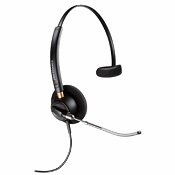
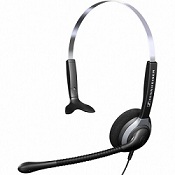
Plantronics EncorePro 510 Voice Tube and Sennheiser SH 200
Noise-Cancelling
The next step on the continuum is Noise-Cancelling. This microphone design eliminates the majority of background noise. Upgrading to a noise-cancelling microphone is well worth the minimal extra dollars, if your environment tends to have area noise. Digital Signal Processing (DSP) is one technology used to largely reduce background noise, enhancing understanding as well as efficiency of calls. Colleagues, wind and other ambient noises are filtered out and therefore not transmitted to your caller through the microphone.
Noisy contact centers, open concept office environments and mobile workers are great candidates for these noise-cancelling microphones.
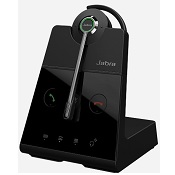
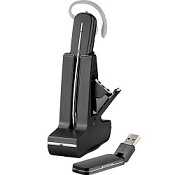
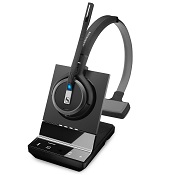
Wireless Solutions: Jabra Engage 65 Convertible, Plantronics Savi W445 and Sennheiser SDW 5033
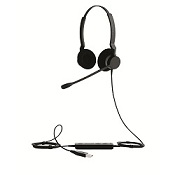
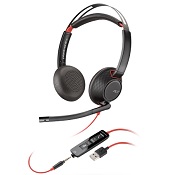
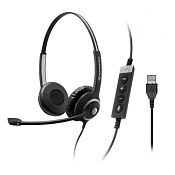
Corded Solutions: Jabra Biz 2300 USB Duo MS, Plantronics Blackwire 5220 and Sennheiser SC 260 MS II
Ultra Noise-Cancelling
Ultra Noise-Cancelling microphones offer absolutely the best noise cancelling technology on the market. The placement of the micron components have been moved away from the entrance to the diaphragm, so the openings on both sides of the diaphragm are symmetrical. The effect is a near-elimination of background noise.
Take note that these microphones do tend to be a bit sensitive in regard to microphone positioning. The microphone should always be positioned precisely near the mouth in order to avoid the headset cancelling out all sounds - including the user's voice!
These microphones are best for extremely noisy contact centers and offices.
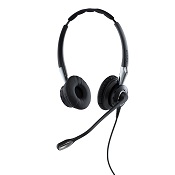

Jabra Biz 2400 II and Sennheiser SC 638
For more information about the importance of Microphone Positioning, read Part 2 of our blog post series.
The 3 Keys to Controlling Background Noise in your Contact Center
.jpg) The professional contact center defines a customer's perception of your company and is a key component to company success. Your agents are the first, and sometimes only,
contact your customers have with your business! There is no greater frustration for a customer than calling a business with a quick question or complaint – only to find
the contact center agent is unknowledgeable, unhelpful or difficult to understand. If the agent works in a noisy center and the customer can hear conversations in the
background, the impression of an amateur organization is made.
The professional contact center defines a customer's perception of your company and is a key component to company success. Your agents are the first, and sometimes only,
contact your customers have with your business! There is no greater frustration for a customer than calling a business with a quick question or complaint – only to find
the contact center agent is unknowledgeable, unhelpful or difficult to understand. If the agent works in a noisy center and the customer can hear conversations in the
background, the impression of an amateur organization is made.
You can virtually eliminate background noise in your contact center with the 3 E's: Environment, Expectation and Equipment.
 Josh Reeves,
CEO of Entero Solutions (a BPO consulting firm), has worked in the contact center industry since 1999.
He shared some valuable insights into structuring a professional (and quiet) contact center.
Josh Reeves,
CEO of Entero Solutions (a BPO consulting firm), has worked in the contact center industry since 1999.
He shared some valuable insights into structuring a professional (and quiet) contact center.

- Environment
Make sure there is plenty of space between agents! Reeves suggests that alternating agents by their tasks helps: alternate voice products, live chat, e-mail callbacks, and order entry, so that not all agents who work primarily on the phone are grouped together. When building the center, think about noise-controlling features from top to bottom: egg carton acoustic foam pieces in higher ceilings, as well as sound absorbing ceiling tiles. On the walls, designs can be created with sound absorbing fabric. Cubicle partitions can be made with those same fabrics and partitions can be built taller so agents aren't directly looking at each other. For the floors, carpet works best to trap sound.
- Expectation
Maintaining near-silence on the call floor, outside of calls, is important. If you think of this as "library quiet" you've got the right idea! Employees should have the expectation that chatting with each other between calls is kept to a minimum. Visitors to the contact center should be made aware of the quiet policy, and signs posted throughout the center are effective reminders of being mindful of noise levels.
Customers, too, have expectations. They trust your company with their personal and confidential information and presume that they will speak one-on-one with your company's representative. This trust can soon be lost if the customer is able to hear other conversations in the background. Reps who speak over your customers because they are unable to hear the phone conversation, also lose the trust of your customers.
- Equipment
Reeves advises centers to "give agents the best equipment possible to get the results you're looking for." Two-ear (duo) headsets with noise-cancelling microphones are the best choice, says Reeves: "They (agents) can hear really well, and in turn, not have to speak as loud. They can maintain focus on the customer they are working with."
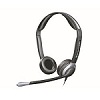 Additionally, ultra noise-cancelling offers enhanced noise-cancelling properties which carry your employees' voices so they can speak at normal, professional levels and still
be heard by your customers. These microphones are best for the loudest contact centers, particularly outbound centers. The enhanced noise-cancelling microphones keep the
background noises from disrupting conversations – essential to maintaining a professional contact center image.
Additionally, ultra noise-cancelling offers enhanced noise-cancelling properties which carry your employees' voices so they can speak at normal, professional levels and still
be heard by your customers. These microphones are best for the loudest contact centers, particularly outbound centers. The enhanced noise-cancelling microphones keep the
background noises from disrupting conversations – essential to maintaining a professional contact center image.
Sennheiser's exclusive noise reduction technology, Adaptive Intelligence™, uses a complex digital signal processor to eliminate incoming and outgoing noise automatically, all while preserving the speech of the using parties. When moving from one dynamic noise environment to the other, the headset automatically compensates according to the unique environment and the users' preferences.
 Amplifiers play a role as well. These sound management devices
detect when the agent is not talking, and automatically lowers the microphone signal reducing outgoing background noise. The caller experiences a quiet pause rather than annoying
background chatter! An amplifier quiets the line from the noises, crackles and background hisses, and offers hearing protection from the sometimes loud sound spikes that occur
during calls. For less than $100, amplifiers make an inexpensive addition to the total sound package.
Amplifiers play a role as well. These sound management devices
detect when the agent is not talking, and automatically lowers the microphone signal reducing outgoing background noise. The caller experiences a quiet pause rather than annoying
background chatter! An amplifier quiets the line from the noises, crackles and background hisses, and offers hearing protection from the sometimes loud sound spikes that occur
during calls. For less than $100, amplifiers make an inexpensive addition to the total sound package.
Reeves also suggests checking into warranties for the headsets. "I think it's important when getting your headsets that they have a good warranty because they're used, in some cases, 24 hours a day," says Reeves. Jabra, Plantronics and Sennheiser all offer at least a 2-year warranty for their corded headsets.
When all three keys have been effectively implemented – Environment, Expectation and Equipment – a quiet, professional contact center is the result. Your customer, and your employees, deserve nothing less than the best!


